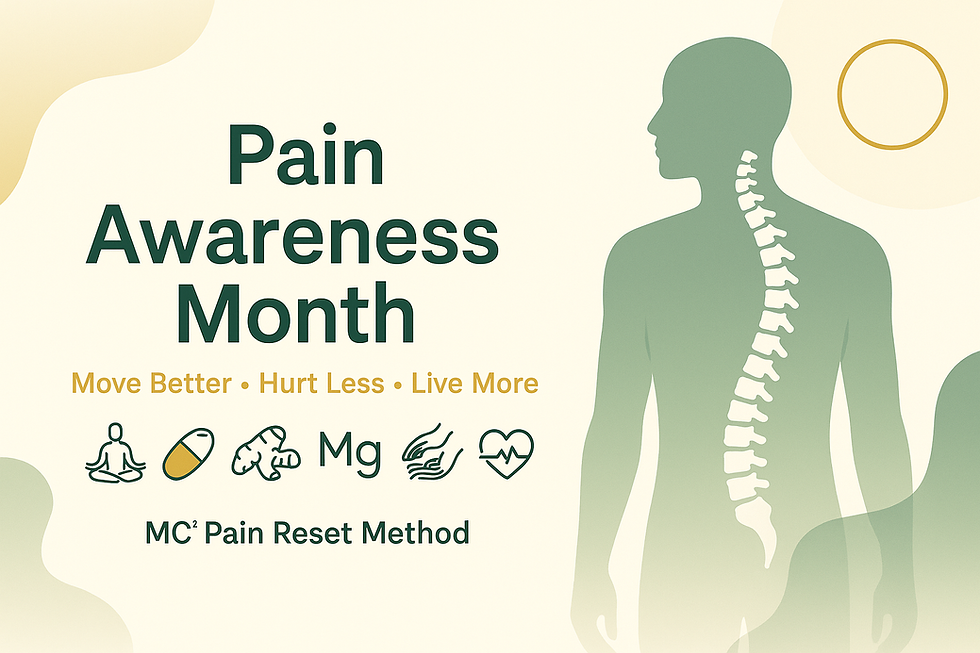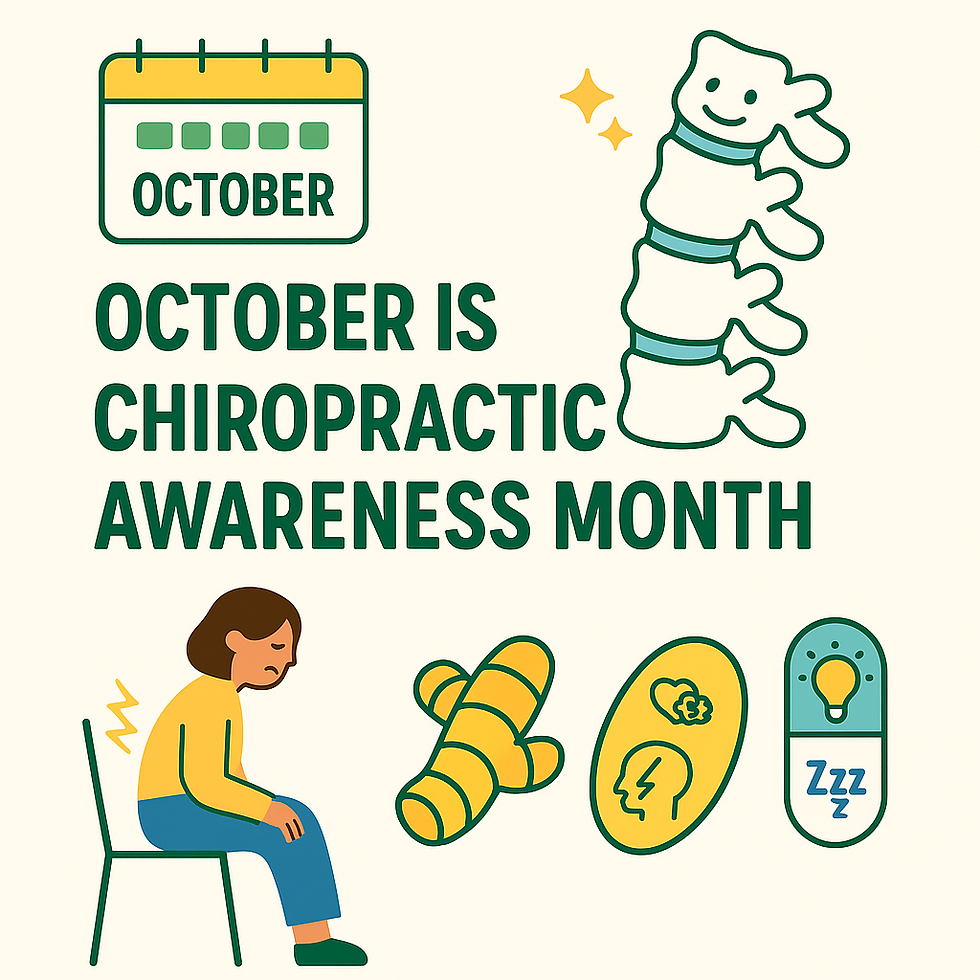September = Pain Awareness Month: Move Better, Hurt Less
- Jacob McNamara
- Sep 1
- 3 min read
Updated: Oct 10
Chronic pain isn’t just “a bad back.” Most people deal with a mix of posture stress, inflammation, and weak or stiff movement patterns. This September, we’re spotlighting simple, proven steps to help you move better, hurt less, and get back to what you love.

Why Pain Persists (and What You Can Do)
1) Posture & Alignment: Hours at a desk and on phones can create forward-head posture and rounded shoulders. Over time, joints compress, muscles overwork, and nerves get irritated—cue neck, shoulder, and low-back pain. A targeted chiropractic assessment and precise adjustments restore motion and reduce mechanical stress, while soft-tissue work or shockwave can calm stubborn hotspots.
2) Inflammation from Lifestyle: Ultra-processed foods, poor sleep, and chronic stress elevate inflammatory messengers that sensitize your nervous system. We focus on real-food nutrition, sleep hygiene, stress management, and—when appropriate—high-quality omega-3s and curcumin to support a healthy inflammatory response.
3) Weak Core & Limited Mobility: When stabilizers underperform (and hips/thoracic spine are stiff), the body compensates with painful movement patterns. A brief, consistent routine—think McGill curl-ups, side planks, hip hinges, and basic mobility—builds durable support so relief lasts.
Our Integrated Care Method (MC² Pain Reset)
Evaluate: posture, movement, and regional interdependence to find your pain drivers.
Adjust: precise spinal/extremity adjustments to restore joint motion.
Release/Regenerate: soft tissue care; shockwave for chronic tendon pain when appropriate.
Stabilize: a progressive core + mobility plan to lock in gains.
Supplement Smart: targeted support for inflammation, muscle tension, and recovery.
September Special: The Pain Reset Package
For Pain Awareness Month, book our Pain Reset Package—a comprehensive consultation and exam followed by your first-visit treatment (precise adjustment + shockwave or massage as appropriate). We’ll map your drivers (posture, inflammation, mobility) and build a plan that fits your goals and schedule. Limited September slots.
Book: https://mc2health.intakeq.com/booking • Call: (847) 234-2346 Location: 900 N. Shore Dr. #170Lake Bluff, IL 60044

Supplement Spotlight: Pain Relief Essentials Stack
Here’s what we’re spotlighting this month to support recovery between visits:
Curcuplex CR — Highly bioavailable curcumin to support a healthy inflammatory response, joint comfort, and post-workout recovery.
Omega MonoPure® — Advanced monoglyceride omega-3 (EPA/DHA) for excellent absorption; supports healthy inflammation resolution, brain/nerve function, and cardiovascular health.
OptiMag® Neuro — Gentle, well-absorbed magnesium blend (including L-threonate) to relax tight muscles, improve sleep quality, and promote calm focus.
Bundle & save this month only. Ask our team for a quick, personalized recommendation based on your goals, medications, and health history.
SHOP HERE: https://drjacobmcnamara.myshopify.com/
A 5-Minute Daily Reset (Try This at Home)
Posture breaks: every hour, do 10 chin tucks + 10 thoracic extensions.
Stability set: 5–8 quality reps of McGill curl-up (each side), 15–30-second side planks.
Hip hinge practice: dowel along spine (back of head–mid-back–tailbone) to groove safe bending.
Mobility: 1–2 minutes of hip flexor stretch and gentle T-spine rotation.Small, consistent reps beat occasional long workouts for pain control.
FAQs
Is chiropractic safe and evidence-based? Major guidelines recommend non-drug options—like spinal manipulation, exercise, and education—for many back and neck pain cases. We tailor care to your exam findings and preferences.
How long until I feel better? Many people notice relief in the first few visits. Durable change comes from pairing in-clinic care with your home routine and smart lifestyle shifts.
Do I need supplements? Not always. But when inflammation, sleep quality, or muscle tension are part of the picture, targeted support can help your results “stick.” We’ll help you decide what’s appropriate.
References & Further Reading
American College of Physicians Guideline: Noninvasive treatments for low back pain (Ann Intern Med, 2017).
Global reviews on exercise therapy and core stabilization for chronic low back pain.
Research on dietary patterns, sleep, stress, and systemic inflammation in chronic pain.
Evidence summaries on omega-3 fatty acids (EPA/DHA) and curcumin supporting a healthy inflammatory response.
Clinical guidance on magnesium for muscle and nerve function.
Educational content only; not medical advice. Consult your healthcare professional—especially if you’re pregnant, nursing, on blood thinners, or managing medical conditions.




Comments